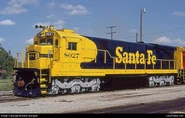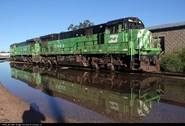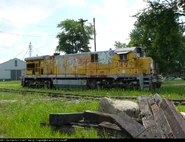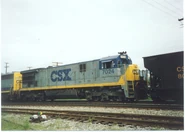Bio
The GE (General Electric) C30-7 (or simply "Dash 7") is a type of six-axle, 3,000hp, 16-cylinder diesel locomotive built from 1976 to 1986 with 1,078 built (including 50 C30-7A units). 783 were sold to American railroads, while the remainder were exported or assembled in Mexico.

An ATSF C30-7. ATSF #8759 is among one of 157 units built for the large western carrier, for the railroad amassed the second largest fleet behind Burlington Northern (BN), whom had 242 units. Despite being large domestic owners, FNM of Mexico was the largest owner of the locomotive model and amassed a total of 305 units.
Various different US Class 1 railroads and major Latin American Class 1 railways ordered the model, most notably Ferrocarriles Nacionales de México (FNM), Burlington Northern (BN), Santa Fe (ATSF), Union Pacific (UP), Conrail (CR), the Norfolk And Western (N&W), Seaboard Coast Line (SCL), Louisville and Nashville (L&N), and the Ferrocarril del Pacífico (FCP) were among the original owners.
The locomotive type or model is one of the several members of the revolutionary Dash 7 line; for the line and subsequent model further contributed towards GE's success as being the top locomotive builder beginning in 1987 with the introduction of the increasingly-successful Dash 8 line.
Very few still remain in active service (notably on shortlines and regional carriers), for models like the EMD SD40-2; its rival, have outlived or outlasted the locomotive entirely. Many are currently in service throughout the Latin American region (notably in Mexico and Brazil), and are previously from mixed ancestry.
BNSF and CSX were among the last domestic carriers or railroads to fully retire all of their C30-7 (and subsequent variants) from their respective rosters from 2005-2009.
History
In the 1970's, a rough and stressful time period in American history became an apparent issue that affected the fuel economy in the following decades after it first began: the 1973 Energy Crisis, which inflated oil prices drastically as a result of conflicts overseas in the Middle East and high consumption from vehicles at the time, further reducing the amounts of fuel barrels traded between both places as well as decreasing the amounts of fuel available. Such economic disaster affected the way Americans traveled and transported goods, passengers, and other commodities for many generations to come, for several years later in 1979, an even greater spike in oil prices devastated the economy even more drastically and further contributed towards a recession beginning in the early 1980's.
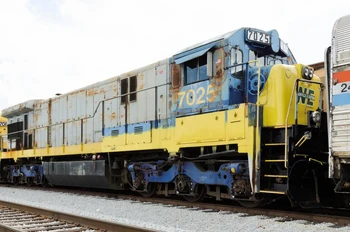
Ex-CSX (nee SCL) C30-7 owned by the NERR (Nashville Eastern Railroad).
To solve these issues, GE developed the Dash 7 line to accommodate government regulations regarding fuel consumption, noise levels, emissions (for emissions from motor vehicles contributed towards heavy smog levels at the time), and further reducing operating costs for railroads. Intended to be an improvement or enhancement of the Universal Series, the Dash 7 line was also built in response to EMD's "Dash 2" line. From these improvements came an enhanced electrical system and improved reliability regarding the prime mover, traction motors, and cooling system. Among said features were previously introduced in GE's "XR Series" U-Boats and subsequent later units (such as the U33C) which were produced years prior to the debut of the Dash 7 line. In an effort to meet said increasing demands from active railroads at the time of the line's official launch in 1977, GE opted to make small minor improvements throughout the duration of the model and subsequent line's run, such as introducing their "silencer" exhaust stack present on most later four-axle models like the B23-7 and B30-7, as well as including baffle plates shielding the radiator section intended to reduce noise from the radiator fan (said plates were soon removed). To improve maintenance for crews, the oil coolers were also relocated and housed on the rear of the hood towards the radiator section, further giving an otherwise pronounced appearance.
At the height of the coal boom in the Powder River Basin, GE out-shopped BN C30-7 #5500 from Erie as a preproduction test-bed, and was among the first of many to be delivered to the railroad. Meanwhile, neighboring companies Union Pacific (UP) and Santa Fe (ATSF) acquired a large number of units to fulfill coal and intermodal duties. Though, said units were often found typically assigned to mixed freights or manifests towards the end of their run. Meanwhile, eastern carriers like Conrail received a rather small number of only 10 units, whereas Norfolk And Western (N&W) received 80. The Seaboard Coast Line (SCL) however, received 71, while the Louisville And Nashville (L&N) received 44 prior to the Family Lines/Seaboard System merger in 1982. Despite having sold in far less numbers than the SD40-2 (it's initial rival) domestically, it sold relatively well down south in Mexico. FNM embraced the C30-7 and subsequent models with great enthusiasm, for they acquired 301 units of the model; far more than any domestic carrier. At least 71 of the units ordered by the railway were assembled at the company's Aguascalientes shops, using kits supplied from Erie. An additional order was then cancelled after the last units began production. After languishing in the back lot at Erie for many years, most of the frames built for the terminated order eventually were salvaged and used on the construction of FNM's C30-7N "Super 7" units built between 1990-1991. The FCP, however, received only 26, and were inherited by FNM prior to when they were consolidated and became FXE (Ferromex) in 1997.
What primarily began GE's success with the Dash 7 models was the presence of GE's long-running 7FDL engine line, for the four-stroke 7FDL-16 found present on the C30-7 proved to be far more fuel-efficient than EMD's two-stroke 645 engine series at the time of production. What further proved this theory, were studies recorded between the 11-year run which revealed that fuel consumption from the Dash 7 locomotives was reduced by about 16%. During said time period, more railroads caught on to the Dash 7's success, and began replacing preceding U-Boats as well as the tried and failed ALCO DH and Century Series units which failed to meet emissions and fuel consumption regulations at the time. Although the previous locomotive models were reliable, they unfortunately failed to meet standard market demands or market standards that were implemented by the FRA (Federal Railroad Association) and EPA (Environmental Protection Agency) during both recessions. And despite the fact that the latter had a much higher horsepower rating than most EMD locomotives at the time of their initial production, they lacked the same standards that were soon met by both GE and EMD years after ALCO closed their doors in 1969. However, the Canadians were particularly fond of their MLW-built units, for they weren't affected by emissions and fuel consumption laws, and continued to utilize them in primary service until the mid-1990's when they were replaced with models like the GE C40-8M and AC4400CW.
For the first time in diesel locomotive history, the C30-7 marked the year when GE outsold EMD in the so-called "horsepower race". With the imminent failures of their "50 Series" line, EMD unfortunately suffered crippling loses with their GP50 and SD50, as a result of both products having been rushed to the market (apart from not fully meeting regulations at the time)
Today, the C30-7 is among one of the many one-prominent active GE locomotive models that is currently endangered, for only small numbers of units reside in operation on various shortlines, leasing companies, and/or regionals. Internationally, however, many are currently in general revenue service with various railways from across the globe; most notably with ALL (América Latina Logística) in Brazil, and EVR (Eesti Raudtee) in Estonia.
C30-7A
Four years after introducing the 12-cylinder, 3,000hp B30-7A, GE applied the concept to a six-motor model. While the B30-7A sold considerably well, GE opted to gain interest in the booming six-axle popularity and further reducing operating costs by introducing the 12-cylinder, 3,000hp C30-7A, which consumed less fuel and generated less noise and emissions than its 16-cylinder counter-part. Although nearly identical to its increasingly-popular predecessor, the C30-7A gained interest with Conrail, for the railroad ordered 50 units. Unfortunately, the model only generated said exact amount, for the locomotive was built exclusively for one customer domestically and failed to gain as much popularity as the original C30-7 model did internationally. However, the C30-7A was far more widely used and popular with the railroad, for Conrail only ordered 10 C30-7 units several years prior to the delivery of their first subsequent C30-7A's.
Although domestic production of the model was limited, GE Brazil continued to construct a variant of the model as late as 1990.
C30-7Ai
The C30-7Ai ("i" meaning, "international") is the foreign export designation for the rebuilt 19 ex-Conrail C30-7A units which were exported to Estonia following the 1999 split between CSX and NS in 2003. They are often classified as "Class 1500" by their current respective owner: EVR (Eesti Raudtee), and are numbered 1558-1576.
Spotting Features
Although mechanically similar to the U30C (its initial predecessor), the C30-7 should not be confused for other GE models from the Universal and Dash 7 lines.
- One notable difference would be the presence of radiator "wings" or "fins", which were once commonly found on later U-Boat models like the U33C.
- Large, distinct "box" located at the rear hood in front of the radiator section housing the oil coolers (not present on any U-Boat model).
- Eight power-assembly access doors or hood panels in engine hood, indicating the presence of a 16-cylinder engine.
- Most early units rode on GSC/GSC-2 trucks, while later units rode on Adirondack trucks present on Dash 8 models.
- The fuel tanks are often noticeably larger (depending on owner specifications).
Identification
"C" - Means, "C-C" or "Co'Co", meaning "six-axle".
"30" - Referring to the horsepower rating.
"-7" - Referring to the "Dash 7" locomotive line.
Flaws
Although reliable, the C30-7 (like every other GE model) was built solely for conventional purposes; meaning that it was built to serve one purpose and eventually become replaced years later. However, one notable flaw apart from the warranty was the nuisance of "throttle lag", meaning that it took longer than usual for the axles to load or respond whenever the throttle of the locomotive were to be moved at any position. Because of the relay distance and time between the prime-mover and traction motors, many engineers often deemed the locomotive to be somewhat problematic regarding the apparent lag. In spite of these issues, the C30-7 has since served as a milestone for GE.
Production Roster
|
Owner |
Road Number(s) | Quantity | Date Built |
|---|---|---|---|
| Burlington Northern (BN) | 5500-5599, 5000-5141 | 242 | 1976-1981 |
| Conrail (CR) | 6600-6609 | 10 | 1977 |
| Conrail (CR)* | 6550-6599* | 50* | 1984* |
| Ferrocarril del Pacífico (FCP) | 434-359* | 26 | 1981-1986 |
| Louisville And Nashville (L&N) | 7000-7015, 7032-7051, 7062-7069 | 44 | 1979-1980 |
| Ferrocarriles Nacionales de México (FNM; N de M) | 6700-6799, 9600-9652, 11001-11148 | 301 | 1978-1986 |
| Norfolk And Western (N&W) | 8003-8082 | 80 | 1978-1979 |
| Santa Fe (ATSF) | 8010-8166 | 157 | 1977-1981 |
| Seaboard Coast Line (SCL) | 7016-7061, 7070-7094 | 71 | 1978-1981 |
| Union Pacific (UP) | 2415-2539, 2960-2974 | 150 | 1977 |
Note*: CR 6550-6599 are C30-7A's.
Note*: FCP 434-359 not numbered in sequential order.
Note*: Production totals do not count towards domestic exports.
Specifications
| Model | C30-7 | C30-7A |
|---|---|---|
| Production Dates | 1976-1986 | 1984 |
| Total Built | 1,078 | 50 |
| Length | 67' 3" | 67' 3" |
| Wheel Arrangement | C-C | C-C |
| Engine | 7FDL-16 | 7FDL-12 |
| Horsepower | 3,000 | 3,000 |
| Alternator | GTA11 | GTA11 |
| Traction Motors | 752 | 752 |
| Weight x 1,000 lbs. | 359-420,000 | 390,000 |
Trivia/Facts
As of 2013, two ex-BN C30-7 units currently await their next fate on a siding at Alliance, NE. Both units were the only active BNSF C30-7 units to not receive patchwork, and have been retired since 2005. Many domestic C30-7 units have since been exported to Mexico and elsewhere south of the border, though some have managed to find their way back; but rather in leasing service (similar to the Hamersley Iron C30-7 units leased to NS in 2001-2002).
Gallery
Sources
http://www.rrpicturearchives.net/locoPicture.aspx?id=8767
http://www.amazon.com/Locomotives-Modern-Diesel-Electric-Reference/dp/1554078962
http://www.amazon.com/Modern-Locomotives-Horsepower-Diesels-1966-2000/dp/0785826815

